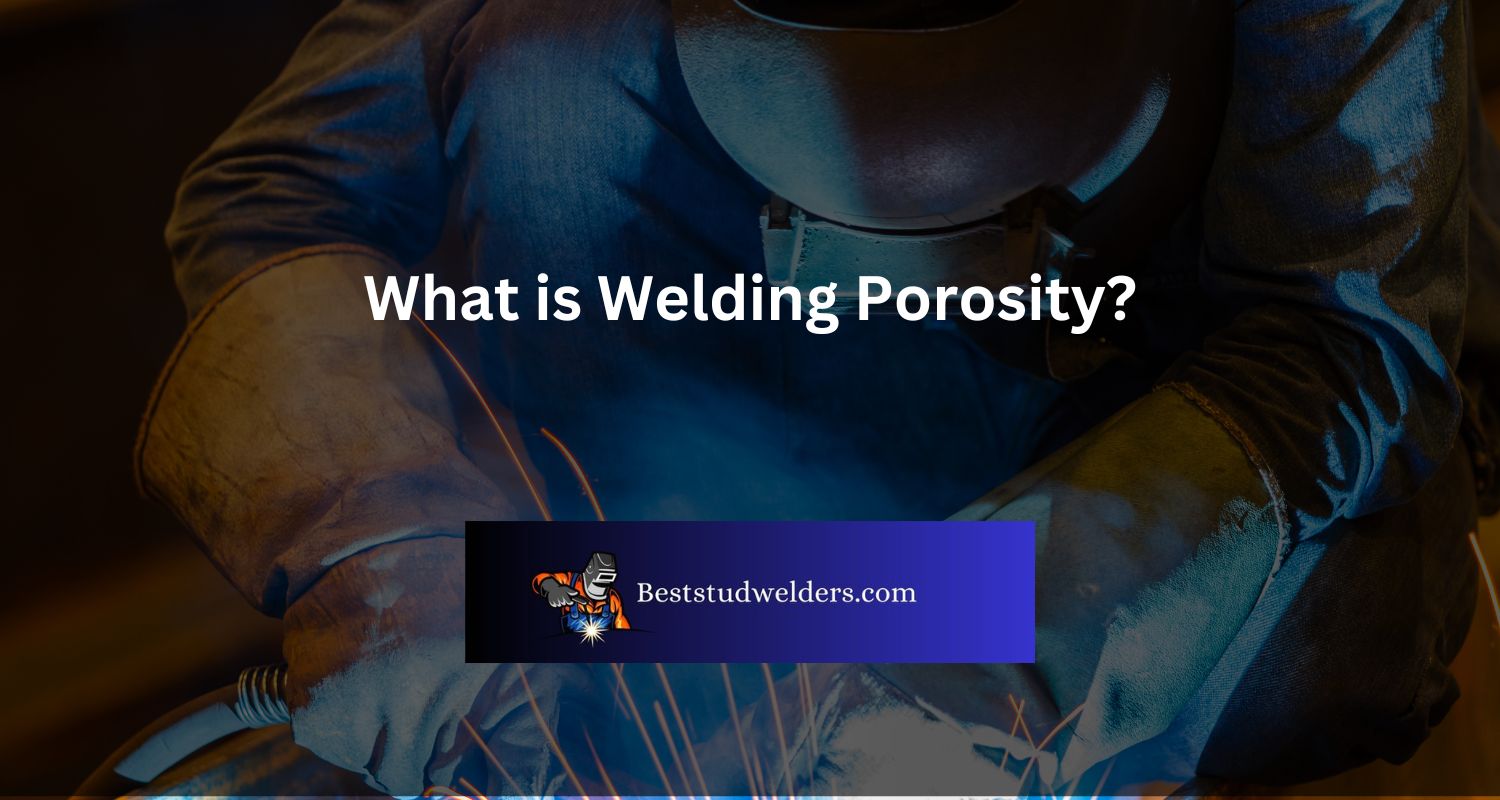Welding porosity is an issue that can affect the quality of your welds, reducing their strength and reliability.
Porosity is a common welding defect caused when gas gets trapped or residue formed in weld joints during the actual welding process.
Understanding what causes porosity and how you can detect it will help ensure that your finished product meets safety standards so you don’t have to start over from scratch.
In this blog post, we’ll discuss what welding porosity is, its causes and remedies for detecting and preventing it.
Understanding Welding Porosity
Welding Porosity can weaken material, cause structural failure and be a major headache. It happens when gas gets trapped in the weld bead. Causes include moisture, rust, oil, grease, and other contaminants on the metal surface. Plus, incorrect shielding gases or lack of heat input can lead to porosity too.
Inspect before welding! Scrub off rusts and scales, use dry equipment and consumables, and check all requirements. Proper maintenance and technique are key to reducing porosity. So, always make sure to double-check tolerances before starting up welding operations.
Causes of Welding Porosity
To understand why welding porosity occurs, you need to dig deeper into the causes behind it. Inadequate shielding gas, moisture contamination, poor surface preparation, and using the wrong welding technique can lead to porosity. In this section of the article about welding porosity, we will explore these sub-sections to give you a deeper insight into the problem.
Inadequate Shielding Gas
Inadequate Shielding Gas can lead to Welding Porosity– when the flow rate and quality of the shielding gas are not up to spec. Causes include blockages, poor equipment maintenance, and bad quality gas cylinders. Improper adjustments or inadequate nozzle size can also contribute.
To prevent this problem, maintain proper equipment setups and clean away debris. Reduce Welding Current or Voltage to avoid overheating. Widen nozzles and provide additional support with back-up bars.
Routine maintenance checks should be done on all equipment systems before use. High-quality gas cylinders and following manufacturer guidelines for flow rates can minimize costs associated with faulty welds. Moisture and welding would be porosity: full of holes and never quite solid.
Moisture Contamination
Welding Porosity may arise from Moisture Ingress. This is when water or other liquids get on the metal surface or the electrode coating. When these materials come in contact with the welding arc, they vaporize and create gas pockets in the weld.
To prevent this, electrodes must be properly stored. The Electric Welding Institute advises storing them in dry ovens at the recommended temperature before use. Additionally, preheating the workpiece can remove any moisture residue on its surface.
High humidity levels in the environment can also lead to Moisture Contamination. Therefore, store welding equipment in a dry place when not in use.
An example of Moisture Contamination happened when a welding company used an electrode without proper storage. The weld had excessive porosity that caused a product failure during use. This damaged their reputation and caused financial loss. This highlights the need for proper precautions while handling welding electrodes.
Poor Surface Preparation
Surface imperfections can lead to welding porosity. Dirt, grease, or oil on the weld surface create a barrier that stops complete penetration of the filler metal. As a result, gas pockets form within the weld. Rust and scale from uncleaned materials will also cause welding porosity.
Poor surface preparation causes problems with weld formation. Contaminants can stop complete bonding between the filler and base material, causing voids. This leads to bad mechanical properties or even failure.
A lack of cleaning before welding is one reason for welding porosity. Other causes include non-conventional techniques like air blowing or brushing instead of power/surface washing, grinding, etc.
Researchers have found that automated ultrasound examination is better than visual inspection for reducing inspection time and increasing reliability.
Surface preparation is key for quality work results. The wrong welding technique is like trying to light a candle with a flamethrower – it won’t be good!
Wrong Welding Technique
Text: Wrong Applying of Welding Method
A crucial factor of welding porosityis wrong application of welding method. Poor understanding of welding types, tools and techniques can cause inadequate penetration. This will make the weld porous and structurally unsound.
Also, poor selection of filler rod can cause porosity in weld joint. Insufficient heat or too much speed during welding can prevent proper fusion between base metals, and create holes and gaps in weld pool.
If base metals are not clean or prepared properly before welding, it can bring about gas pockets in weld bead.
Incorrect application brings about incorrect results. Welders require comprehensive training on particular method and materials from a certified expert before welding.
According to https://www.twi-global.com/, porosity is formed when gases get trapped in solidifying cooling metal- caused by various factors, including wrong welding technique.
Searching for welding porosity is like looking for a needle in a haystack. Except, the needle is a tiny gas pocket, and the haystack is molten metal.
.jpg)
Detecting Welding Porosity
To detect welding porosity in your projects, use visual inspection, X-ray inspection, or ultrasonic inspection. Each of these methods has its own advantages and limitations, allowing you to select the most appropriate approach according to your needs. Visual inspection is a quick and simple method to detect small pores, while X-ray and ultrasonic inspections offer more detailed information through non-destructive testing.
Visual Inspection
Scrutinizing welded joints for potential defects is an important part of quality control. An experienced professional can make sure every centimeter complies with industry standards.
Visual aspects, such as shape, size, and color, can reveal if there’s any porosity. These small holes weaken the bond between metal pieces, reducing their lifespan and structural integrity.
Examining welds requires proper lighting and different angles to spot hidden flaws in porous areas. Inspectors may also use magnifying lenses or borescopes to get a more detailed look.
Pro Tip: Irregularities can point to underlying issues that need further investigation. Make sure to cast a critical eye over every millimeter of your weld to avoid problems later. Get a peek at what lies beneath with x-ray inspection – no copay needed!
X-ray Inspection
X-ray Inspection is a popular, effective method for Non-destructive Testing. It identifies internal flaws and porosity in welds, as well as potential remediation before damage occurs. The process uses X-rays to detect inconsistencies in the material’s molecular structure.
Experts can create clear images to identify any potential faults or defects that may not be visible with traditional visual inspections.
Regular X-ray inspection procedures are critical for making sure structural integrity and operational reliability are maintained. A recent study conducted by ‘Welding Journal’ showed that over 70% of welding failures were due to porosity.
Consequently, thorough testing is necessary to ensure safe working conditions and prolonged product longevity. If you want to make sure welding porosity is taken care of, then consider ultrasonic inspection!
Ultrasonic Inspection
Modern testing methodologies employ advanced technologies, such as high-frequency sound waves and sensors, to non-destructively analyse welding components for possible defects. Ultrasonic inspections are now the preferred method for detecting welding porosity.
Ultrasonic testing uses high-frequency sound waves that penetrate materials at various depths. This allows inspectors to identify any misalignment or porosity without damaging the material. Plus, they can also measure material thickness before and after welding.
The tech behind this has come a long way. Early on, it was mostly destructive and used only on simple geometry metals. Nowadays, digital signal processing provides more accurate real-time results with minimal setup. Plus, data analysis tools can store test results for future reference.
To get accurate ultrasonic inspection results, best practices include:
- Selecting an appropriate probe frequency.
- Calibrating instruments.
- Consistent voltage supply.
- Operator training.
- Reducing surface roughness for couplant transmission.
- Monitoring equipment conditions (e.g. probes, cables).
Porosity in welding can be prevented if caught early – like teenage acne!
Preventing Welding Porosity
To prevent welding porosity in your welds, you need to take certain precautions with your welding materials and techniques. The following sub-sections explain the solutions you need to keep in mind: Proper Selection of Welding Material, Proper Welding Techniques, Adequate Shielding Gas, and Proper Surface Preparation.
Proper Selection of Welding Material
Choosing welding materials is key. Consider the type of base metal, application, and technique used. Wrong selection leads to porosity, which weakens the structure and can cause damage.
To make the right choice, create a table with characteristics such as tensile strength, ductility, and heat resistance. This ensures the material is compatible with the base metal and process. For mild steel, popular electrodes are E6010, E7018, and E70S-6.
Keep in mind that the material must fit its purpose. For instance, a high-strength electrode like E10018 is unsuitable for low-stress activities such as furniture manufacturing. The welding method used could also affect the choice.
In the past, inadequate knowledge when selecting welding materials caused welded structures to fail. Now, with improved technology and research, proper selection helps maintain structural integrity and extends their lifespan. Learn proper techniques – one wrong step and you could end up all porosity!
Proper Welding Techniques
5 Step Guide to Proper Welding Techniques:
- Identify the metal type and use the suitable welding technique.
- Ensure the surface is clean and free from dirt or oil.
- Set up the equipment properly to prevent contamination.
- Monitor the temperature and adjust for proper weld penetration.
- Cool the weld gradually to reduce stress.
Protective gear and adequate ventilation are essential for safety.
To ensure Proper Welding Techniques, inspect the weld after welding. To obtain optimal results, avoid over-welding and use appropriate shielding gas.
Adequate Shielding Gas
The quality of welding can be affected by many things, such as the type and amount of shielding gas used. Poor protection leads to porosity, a welding defect that weakens the material and its features.
To avoid porosity, it is important to select and use the proper shielding gas. Here is a table with the most important points:
| Shielding Gas Type | Suitable for | Advantages |
|---|---|---|
| Argon | Non-ferrous materials | High purity; low reactivity |
| Helium | Thick sections | Penetrates deeply; hotter arcs |
| Carbon dioxide | Steels | High deposition rate; efficient |
| Oxygen | Stainless steel | Aids oxide removal |
Selecting the right shielding gas is essential, as well as other aspects like flow rate, coverage angle, nozzle size and clearance.
In high-energy welding processes, like plasma or laser cutting, an injector should be used to prevent ionization-induced disruption.
Using the wrong shielding gas can have serious consequences. For instance, an auto manufacturer had to recall thousands of vehicles due to improper welds caused by inadequate shielding in their suppliers.
Using the right shielding gas and applying it properly will make sure the welds are of great quality and reduce porosity issues.
Proper Surface Preparation
It’s essential to prep the surface before welding. Cleaning and prepping can prevent porosity. This helps remove dirt, moisture, oil, and other contaminants that might cause issues.
Different methods for prepping surfaces exist. Abrasive blasting uses materials like sand, glass beads, or aluminium oxide to take away rust or oil. Chemical cleaning uses acid or alkaline solutions to dissolve oils. Solvent wiping involves solvents like methanol to wipe away contaminants.
After prepping, check for defects with fluorescent penetrant inspection (FPI), magnetic particle inspection (MPI) or eddy current testing (ET). FPI uses a liquid dye to detect cracks or holes. MPI uses magnetism while ET uses electromagnetic waves to find surface discontinuities.
When welding on painted surfaces, get rid of the paint first. Also, steer clear of welding through galvanized metal as it makes toxins when heated.
In conclusion, surface prep can eliminate porosity by making sure the surface is clean and free of contaminants. It’s best to leave this task to the professionals.
Fixing Welding Porosity
To fix welding porosity with solutions such as removal by grinding, rewelding, and welding over porosity. Each method poses unique benefits and challenges in addressing the issue of welding porosity.
Removal by Grinding
Eliminating welding metal’s openings and splits can be done with grinding. It’s cost-effective and easy.
- Locate the problem area.
- Pick the right disc based on the material, aluminum or steel.
- Start grinding at a low speed to keep heat and disturbance minimal. Don’t press hard.
- Clean up the metal dust and check that all issues are gone. Repeat if needed.
You should use protective gear, such as gloves, glasses and a respirator, before beginning to avoid injuries.
Drilling is another option.
Welding Hub’s certified inspectors recommend you inspect for pores frequently during fabrication by using penetrant testing. Rewelding is taking risks and might still leave you with porosity.
Rewelding
Repair Welding Defects with Rejoining!
Got porosity? Inspect the welded area to spot it. Clean it up with a wire brush or grinder to get rid of any contaminants. Then, preheat the steel to 200-300°F and create a bevel on both sides of the joint.
Ready to reweld? Make sure to control heat input and maintain correct arc voltage. Don’t overfill the joint and don’t get your positioning wrong.
Inspect again after you’re done. If you still see defects, repeat the rewelding process until the weld looks good. Nailed it!
Welding Over Porosity
Welding can lead to porosity, if materials are contaminated or shielding gas is used incorrectly. Porosity is a type of defect, causing small cavities in the weld metal, limiting joint strength and quality. To prevent this, materials must be cleaned and degreased, and proper shielding gas or flux must be used. If porosity does occur, a different welding process or filler material might help.
Did you know that 20% of weld-related failures are due to porosity? So, make sure to be precise when welding – anything less could result in defective welds.
Conclusion: Best Practices for Avoiding Welding Porosity
To avoid welding porosity & its consequences, it’s essential to follow a 6-step guide:
- Clean the welding surface – no oil, grease or contaminants.
- Check material quality for defects.
- Control arc length – no gaps in between welds.
- Avoid high moisture content.
- Monitor gas flow rates.
- Maintain proper welding technique & parameters.
Other factors to consider: preheat thick materials, clean wire scraps, buy quality filler metals & edges.
Don’t ignore good guidelines or compromise on quality – it could cause severe consequences! I saw a fabrication shop destroyed by an inexperienced welder. He failed to follow metal safety protocols & caused massive metal failure with porosity, resulting in financial losses & ceasing their services.
Frequently Asked Questions
What are some causes of welding porosity?
Welding porosity can be caused by a number of factors, including the presence of moisture, oil, rust or other contaminants in the welding area, improper shielding gas flow, incorrect welding parameters or electrode selection, and poor welding technique.
How can welding porosity be prevented?
To prevent welding porosity, it is important to properly prepare the welding surface by removing any contaminants and ensuring that the area is clean and dry before welding. Correct welding parameters, electrode selection, and shielding gas flow should also be carefully considered, and welding technique should be improved through training and practice.
What are some common methods for repairing welding porosity?
Common methods for repairing welding porosity include grinding out and rewelding the affected area, using a specialized filler material or welding process to fill the voids, or using a low-heat input process such as brazing or soldering.
How does welding porosity affect the strength of the weld?
Welding porosity can significantly weaken the strength of the weld by creating pockets of gas or voids in the metal that reduce its overall structural integrity. This can lead to premature cracking or failure of the weld and compromise the safety and durability of the finished product.
How can welding porosity be detected?
Welding porosity can often be detected visually by looking for signs of gas pockets or voids in the weld, or by using advanced non-destructive testing techniques such as X-ray or ultrasonic inspection. These methods can help to identify and quantify the extent of porosity in the weld, allowing for targeted repairs and improved welding practices in the future.
Paul Dixon is a certified welder with a wealth of experience in welding and related technologies. He started his career as an apprenticeship in welding, where he learned the ropes and acquired extensive skills in the craft.
Over the years, Paul has continued to sharpen his expertise, earning him top-rated welding certification. He remains one of the most outstanding welders in the industry.







